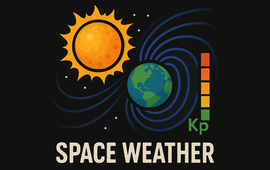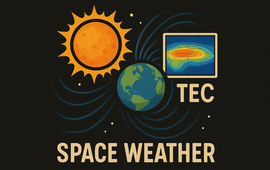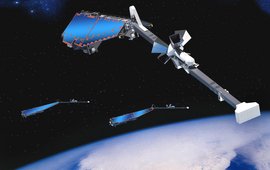Forschungsthemen
The Earth's Magnetic Field
Sources of the Earth's magnetic field
The dominant geomagnetic core field is generated in the Earth fluid outer core. Another part is generated by magnetized lithospheric rocks. A further contribution with high temporal variety originates from sources outside of the Earth (Externel Field). Probably the faintest contribution to the Earth's magnetic field, is generated by oceanic circulations.
Geomagnetic field evolution
The long-term evolution of the Earth's magnetic field in the past is used to draw conclusions about the dynamics of the Earth's outer core and the geodynamo processes that generate the magnetic field. We investigate secular variations of the magnetic core field on time scales from decades to millennia.
Frequently Asked Questions (FAQs)
A list of frequently asked questions (FAQs) and answers to the Earth's magnetic field.
Space Weather Services
Geomagnetic Indices
The GFZ provides both definitive indices and real-time indices for the geomagnetic activity. The most important of these is the Kp index, which was introduced by J. Bartels in 1949 and is calculated from standardized K indices (Ks) from 13 geomagnetic observatories. It was developed to measure the solar particle radiation via its magnetic effects and is now considered a proxy for the energy input from the solar wind into the Earth system.
G-ESC | Products for ESA Geomagnetic Services
This project is a part of the European Space Agency's (ESA's) Space Situational Awareness (SSA) programme, which includes the Space Weather (SWE) Segment. The objectives of this project are to coestimation of the definition and development activities within the Geomagnetic Conditions Expert Service Centre.
I-ESC | Products for ESA Ionospheric Services
This project is a part of the European Space Agency's (ESA's) Space Situational Awareness (SSA) programme, which includes the Space Weather (SWE) Segment. The objectives of this project are to coestimation of the definition and development activities within the Ionospheric Weather Expert Service Centre.
Ground and Satellite based Observation
Geomagnetic observatories
A global network of geomagnetic observatories is the backbone of studies concerning the field sources in the Earth's core, ionosphere and magnetosphere. Moreover, the data are used for models and maps with practical applications, and the determination of magnetic activity indices for space weather monitoring.
Magnetic archives of system Earth
This laboratory deals with magnetostratigraphic dating of paleoclimate archives and the reconstruction of geomagnetic field variation in the geological past, as well as with analyses of magnetic minerals.
ESA satellite mission Swarm
We are involved in the satellite mission Swarm of the European Space Agency (ESA), which observes the geomagnetic field since November 2013. The mission consists of three identical, low-Earth orbiting satellites and also measures ionospheric and atmospheric parameters.
GFZ Satellite Mission CHAMP
CHAMP (CHAllenging Minisatellite Payload) was a German small satellite mission for geoscientific and atmospheric research and applications, managed by GFZ. With its highly precise, multifunctional and complementary payload elements and its orbit characteristics CHAMP generated highly precise gravity and magnetic field measurements simultaneously for the first time and over a 10 years period.
Other satellite missions
Many satellites carry magnetometer as part of its attitude orbit control system (AOCS). The magnetometer does not belong to the scientific payload of the mission. However, after postprocessing the satellites magnetometer data, information on the geomagnetic field and on electric currents in near Earth space can be derived. Platform Magnetometer on ISDC webpage: isdc.gfz-potsdam.de/platform-magnetometer/

![[Translate to English:] Illustration Magnetic Fiel Lines at the Core Mantle Boundary](/fileadmin/_processed_/a/8/csm_core-magfield-sunflower_3eaa037f8a.png)




![[Translate to English:] Photo of the geomagnetic observatory in Niemegk](/fileadmin/_processed_/2/9/csm_Niemegk_f0b89233cc.png)
![[Translate to English:] Cryogenic long-core magnetometer](/fileadmin/_processed_/3/4/csm_P1220145-small_8409f4eada.jpeg)


![[Translate to English:] Illustration des Erdmagnetfeldes, abeleitet aus Daten verschiedener Satellitenmissionen](/fileadmin/_processed_/f/a/csm_platmag_52ac6280ae.png)